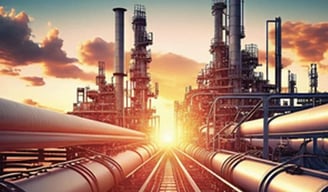Add your promotional text...
India’s Rising Role in Global Oil and Gas Amid a Slowing Chinese Economy
Synopsis India is poised to become a major global hub for oil and gas as it expands its refining, petrochemical, LNG regasification, and pipeline capacities, according to a recent HSBC report. While global oil prices remain weak, India stands to benefit significantly due to its high crude oil import dependency. The report also highlights India's energy transition efforts, investments in renewables, and challenges posed by slowing domestic petroleum demand and competition in the global market.
COMMODITIES
By Ekta Mani
12/10/20243 min read


India's Strategic Shift in the Global Oil and Gas Market
As the Chinese economy decelerates, the global oil and gas landscape is undergoing a major transformation, with India emerging as a key destination for energy investments. The HSBC report sheds light on how India is capitalizing on weak global oil prices and its expanding infrastructure to position itself as a critical player in the industry.
Global Oil Prices: A Boon for India
Global oil prices are projected to remain subdued, a development that bodes well for India, which imports over 80% of its crude oil requirements. Every decline in oil prices results in substantial savings on India's import bill, providing a much-needed boost to the economy.
HSBC maintains its Brent crude forecast at $70 per barrel, with expectations of a balanced market in 2025. However, concerns loom for 2026, as surplus production could intensify if volumes rebound.
Key Insights from the Report:
OPEC+ is expected to maintain its current strategy, but long-term stability remains uncertain.
LNG markets are anticipated to stay tight until 2027, with a supply glut likely emerging afterward.
India's Expanding Energy Infrastructure
India’s strategic energy investments are expected to reshape its role in the global oil and gas market.
LNG Regasification Capacity
By 2025, India is projected to expand its LNG regasification capacity by 25%, significantly enhancing its ability to absorb global LNG supplies.
Refining Capacity
India's refining capacity is expected to grow by 9%, adding 0.5 million barrels per day. This expansion will further strengthen India's position as a refining hub, catering to both domestic and international markets.
Pipeline and Petrochemical Developments
India is also focusing on developing pipeline infrastructure and transforming refineries to orient toward petrochemical production, an area that remains oversupplied globally but is crucial for long-term growth.
Energy Transition Gains Momentum
India’s oil and gas companies are gearing up for a significant shift toward renewable energy and sustainable practices.
Renewable Investments: Companies are initiating investments in renewable energy projects and green hydrogen technology.
Green Hydrogen Blending: Early-stage efforts to blend green hydrogen with existing fuels are underway.
Refinery Transformation: Projects aimed at refinery modernization to focus on petrochemical production are set to take center stage.
These initiatives reflect India's commitment to energy transition and reducing its carbon footprint.
Domestic Petroleum Demand Slows
While India's infrastructure is expanding, domestic petroleum demand is showing signs of a slowdown.
Diesel Demand: Diesel consumption, a significant component of petroleum demand, is declining due to stricter emission norms and the growing adoption of electric and gas-powered vehicles.
Transportation Fuels: Demand growth for high-margin transportation fuels is also slowing, driven by global economic concerns and the increasing penetration of electric vehicles.
HSBC’s Investment Ratings: Opportunities and Risks
The HSBC report outlines specific investment opportunities and risks for key players in India’s energy sector:
GAIL: Rated as a "Buy," benefiting from improved gas infrastructure, stable LNG pricing, and a growing customer base.
HPCL, BPCL, IOCL: All rated as "Buy," taking advantage of weak oil prices and stable refining margins.
ONGC: Rated as "Reduce" due to risks associated with falling oil prices and production challenges.
Petronet LNG (PLNG): Rated as "Hold" amid investments in petrochemicals and competing regasification terminals.
Global and Regional Headwinds
China's Economic Slowdown
China, historically a major driver of global energy demand, is experiencing a significant economic slowdown. This has led to reduced demand for transportation fuels and petrochemicals, creating ripple effects across global markets.
U.S. Policy Uncertainty
Post-election policy changes in the U.S. under Donald Trump have added another layer of uncertainty to global energy markets. Potential shifts in trade policies and tariffs could further disrupt the sector.
India’s Long-Term Prospects
Despite challenges, India is well-positioned to thrive in the evolving global oil and gas market. Key factors supporting this outlook include:
Strategic Investments: Expanding refining and LNG capacities will solidify India's role as a critical energy hub.
Energy Transition: Early adoption of renewable energy and green hydrogen technologies positions India as a leader in sustainable energy practices.
Geopolitical Advantages: With China's slowing economy, India is increasingly becoming the go-to destination for energy investments.
A New Era for India’s Energy Sector
As the global energy market adapts to shifting dynamics, India is emerging as a key player, leveraging its expanding infrastructure, strategic investments, and commitment to energy transition. While challenges such as slowing domestic demand and global economic uncertainties persist, the country’s proactive approach ensures that it remains at the forefront of the industry.
For investors and stakeholders, India's evolving energy landscape offers both opportunities and challenges, making it a space to watch closely in the coming years.
Disclaimer: This article is for informational purposes only and does not constitute financial or investment advice. Please consult a financial advisor before making any investment decisions.
